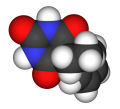Wikisage, the free encyclopedia of the second generation, is digital heritage
Phenobarbitone: Difference between revisions
Jump to navigation
Jump to search
No edit summary |
No edit summary |
||
| Line 8: | Line 8: | ||
https://www.ncbi.nlm.nih.gov/pubmed/12020260 antiepileptic drug-induced bone loss in young male patients who have seizures | https://www.ncbi.nlm.nih.gov/pubmed/12020260 antiepileptic drug-induced bone loss in young male patients who have seizures | ||
==Status epilepticus== | |||
http://www.mdpi.com/2077-0383/5/5/49/htm Treatment of Established Status Epilepticus | |||
==Uses== | ==Uses== | ||
===Human=== | ===Human=== | ||
Revision as of 18:07, 28 November 2016
or phenobarbital is a WHO recommended AED
phenobarbital induces enzymes of the cytochrome P450 system; like phenytoin, carbamazepine, and primidone.[1]
Osteomalatia
https://www.ncbi.nlm.nih.gov/pmc/articles/PMC5000640/pdf/ijms-17-01242.pdf The Impact of Anti-Epileptic Drugs on Growth and Bone Metabolism
https://www.ncbi.nlm.nih.gov/pubmed/12020260 antiepileptic drug-induced bone loss in young male patients who have seizures
Status epilepticus
http://www.mdpi.com/2077-0383/5/5/49/htm Treatment of Established Status Epilepticus
Uses
Human
Veterinary
- ↑ http://www.jfmpc.com/text.asp?2016/5/2/248/192338 Arora E, Singh H, Gupta YK. Impact of antiepileptic drugs on bone health: Need for monitoring, treatment, and prevention strategies. J Family Med Prim Care [serial online] 2016 [cited 2016 Nov 28];5:248-53.
